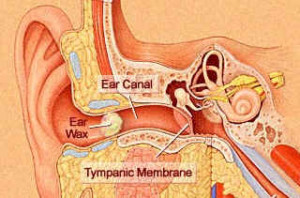Ears and Their Problems
 There are many ear problems
There are many ear problems
Ear wax is formed by two types of glands in the ear canal. It is composed of fat and dead skin cells and is produced to trap debris that may enter the ear canal. An “impaction” is the accumulation of excessive ear wax.
What causes impaction?
Impaction is commonly the result of misguided efforts to remove ear wax. The use of cotton swabs, needles, bobby pins, etc. interferes with the ear’s self-cleaning mechanism and can potentially scratch or puncture the skin. Such attempts to remove ear wax will usually only push it further down the ear canal. Over time, the accumulated wax will create an impaction.
Some people naturally develop impactions due to narrow or deformed ear canals or skin disease near the ear and scalp.
What are the symptoms?
Common symptoms of ear wax impaction are earache, hearing loss, or both. Frequently there is a sudden decrease in hearing following attempts to clean the ear or when water gets into the ear during swimming, bathing or showering. This could be a sign that wax has completely blocked the ear canal.
How is it treated?
Impacted ear wax needs to be removed by a health care professional who can “irrigate” the ear canal with water or wax- dissolving substances or use an ear curette (a special ear cleaning instrument).
What can you do?
If ear wax build-up is a recurrent problem, your health care provider may recommend that you apply a wax-dissolving solution at home:
Lie on your left side. Using a bulb dropper put a solution of equal parts hydrogen peroxide and lukewarm water into your ear canal every 15 minutes. Drain and rinse with water, repeat on other side. Perform this daily for 3-4 days if wax persists.
An occasional (i.e. once a month) rinsing of the ear canals with shampoo lather, followed by a clear water rinse, can be helpful. Do not use this if you have an earache or are otherwise ill.
Consult health care personnel:
- – if you have hearing loss.
- – if you have redness, pain or swelling of the ear canal or discharge from the ear.
- – any time you are unsure about what to do.
Earaches
A problem that the late winter/early spring season brings is ear infections and earaches. Fortunately, you can make your own eardrops. You will need:
Mullein flowers
Olive oil
Garlic cloves
Put about a cup of the mullein flowers in a cup of olive oil in a small pan. (The olive oil should cover the flowers.) Heat this at a very low temperature for several hours, remembering that you only want to extract the beneficial elements from the mullein, not cook it. Put several cloves of garlic in the batch for the second hour. When you can smell the fragrance of the mullein, cool the mixture and strain it well. When you are ready to use it, shake it and use a dropper to put 5-10 drops into the outer ear. Keep your head tilted to allow the oil to penetrate, then you can place a piece of cotton in your ear to keep the oil from leaking out onto your clothing or your pillow.
RECOMMENDED:
We found this company Seagate. It is unusual in the health food industry because they harvest and process their own raw materials, including sharks, grapes and olive leaves. Seagate has been producing a diversity of products for over 18 years.
Earache Remedy by Seagate Products – Earache Remedy is a very safe homeopathic formulation for use by adults and even children. Homeopathy a natural approach to medicine that works without interfering with other medications you may be taking. It has no side effects. It stimulates the body’s curative responses, so the body heals itself.
For more information about what are Homeopathic remedies.
STILL HAVE QUESTIONS? EMAIL AND GET YOUR QUESTIONS ANSWERED.
Sign up to receive the MCVitamins Newsletter!
Up-to-date info on the latest health-related news happening in the world
(available in English only)

